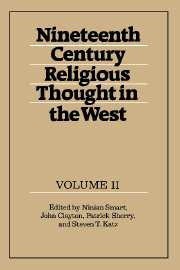Book contents
- Frontmatter
- Contents
- 1 SAMUEL TAYLOR COLERIDGE
- 2 RALPH WALDO EMERSON AND THE AMERICAN TRANSCENDENTALISTS
- 3 JOHN HENRY NEWMAN AND THE TRACTARIAN MOVEMENT
- 4 DREY, MÖHLER AND THE CATHOLIC SCHOOL OF TÜBINGEN
- 5 ROMAN CATHOLIC MODERNISM
- 6 RUSSIAN RELIGIOUS THOUGHT
- 7 BRITISH AGNOSTICISM
- 8 THE BRITISH IDEALISTS
- 9 WILLIAM JAMES AND JOSIAH ROYCE
- INDEX
4 - DREY, MÖHLER AND THE CATHOLIC SCHOOL OF TÜBINGEN
Published online by Cambridge University Press: 06 January 2010
- Frontmatter
- Contents
- 1 SAMUEL TAYLOR COLERIDGE
- 2 RALPH WALDO EMERSON AND THE AMERICAN TRANSCENDENTALISTS
- 3 JOHN HENRY NEWMAN AND THE TRACTARIAN MOVEMENT
- 4 DREY, MÖHLER AND THE CATHOLIC SCHOOL OF TÜBINGEN
- 5 ROMAN CATHOLIC MODERNISM
- 6 RUSSIAN RELIGIOUS THOUGHT
- 7 BRITISH AGNOSTICISM
- 8 THE BRITISH IDEALISTS
- 9 WILLIAM JAMES AND JOSIAH ROYCE
- INDEX
Summary
At the very south of the lands of Germany, standing directly against the Swiss frontier, enclosed to the west by the Black Forest of Baden and open on the east to the rolling plains of Bavaria, lies Württemberg. This countryside, formed mostly of the gentle hill slopes of old Swabia, sheds the waters that fall on it in two directions: some into the valleys feeding the Rhine, which is picking up momentum here for its mighty wash into the North Sea; the rest into the Danube, which has its small start here and then proceeds to drain the entire old Austro-Hungarian Empire on its ponderous way to the Black Sea. It was from Württemberg, and from its ancient university city of Tübingen, that fared forth a formidable school of Catholic theology which would, through the first half of the nineteenth century, have no better in Europe. Theologically, Württemberg was watershed of the Catholic world, with its headwaters in Tübingen.
Duke Eberhard had founded the University in 1477. Haifa century later both duchy and university were given over to the Reformation. In years to come the institution would remember among its students Melanchthon, Kepler, Hegel, and Schelling. That this relatively small academy, settled in a largely Lutheran region, came to be the seat of a sturdy Catholic theological revival, is due to Napoleon Bonaparte as much as to anyone. His energetic efforts to subdue, incapacitate, and despoil the Catholic Church succeeded in freeing the Church's wits to explore the faith it had late been distracted from. In the Treaty of Lunéville, 1801, he arranged to attach the left bank of the Rhineland to France.
- Type
- Chapter
- Information
- Nineteenth-Century Religious Thought in the West , pp. 111 - 140Publisher: Cambridge University PressPrint publication year: 1985



